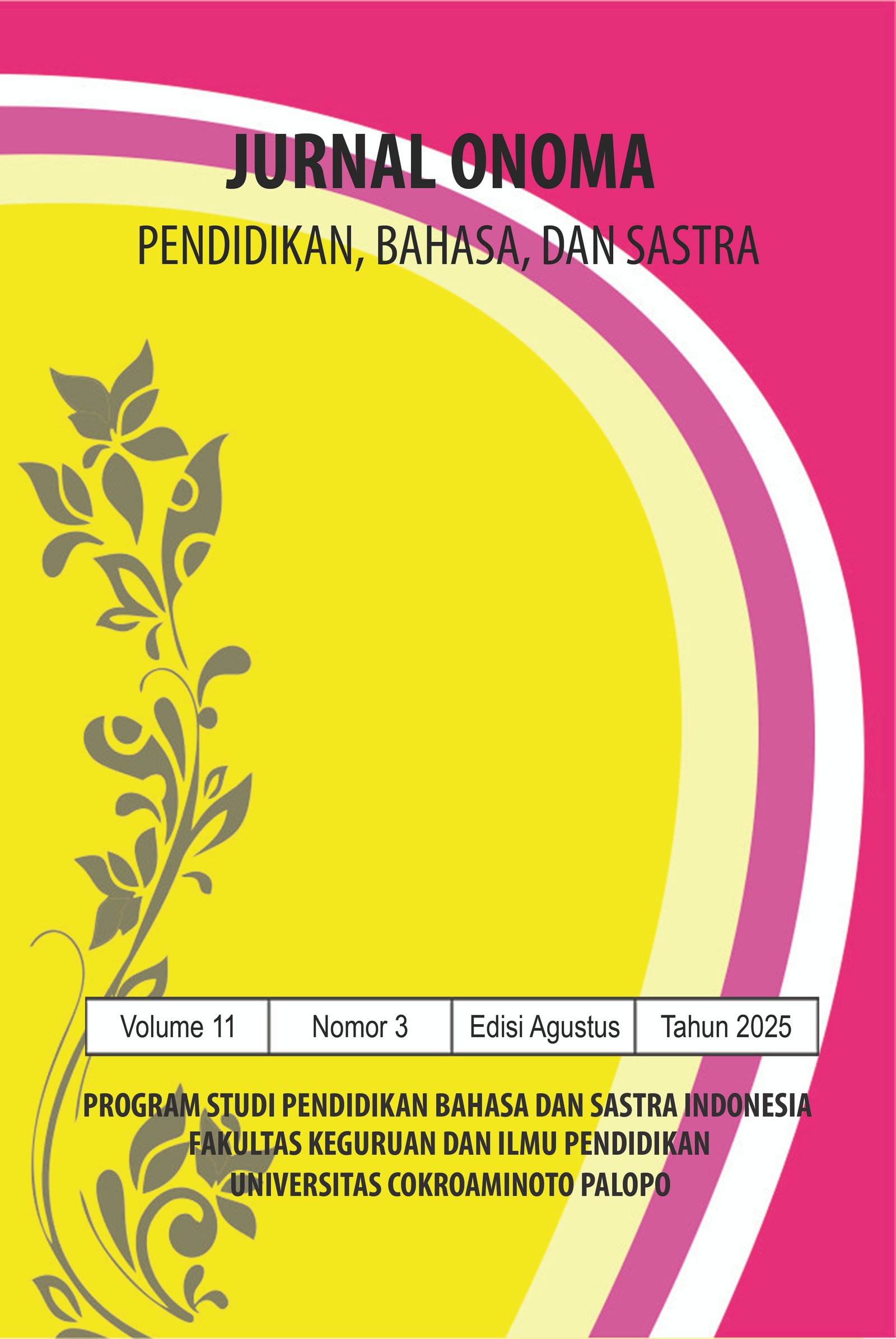Associative Meaning Analysis in a Selected Song from The Rolling Stones
https://doi.org/10.30605/onoma.v11i3.6180
Keywords:
associative meaning, semantics, song lyrics, The Rolling Stones, Leech’s theoryAbstract
This research titled "Associative Meaning Analysis in a Selected Song from The Rolling Stones" examines the presence and function of associative meaning in selected lyrics from the Rolling Stones’ recent works. The objective is to identify and analyze the types of associative meaning found in the lyrics. The study uses a qualitative descriptive approach with content analysis as the primary method. The data source consists of selected lyrical lines, which are analyzed using Leech’s (1985) theory of associative meaning. The analysis reveals six types of associative meaning: connotative, reflective, social, affective, collocative, and thematic. Connotative meaning adds emotional and symbolic depth, such as the phrase “sweet scents of Heaven,” which suggests peace beyond literal scent. Reflective meaning is observed in lyrics that express personal and collective emotions, including nostalgia and national pride mixed with disillusionment. Social meaning reflects cultural values embedded in the lyrics, while affective meaning evokes emotional responses such as joy and innocence, as seen in phrases like “the sweet sounds of children.” Collocative meaning is shown through word combinations like “Heaven” and “earth,” which carry spiritual associations. Thematic meaning is present in repeated contrasts, such as between the divine and the worldly, or between chaos and calm, giving unity to the overall message. These meanings are expressed through imagery, symbolism, and emotional variation, encouraging deeper engagement from listeners. In conclusion, the selected lyrics demonstrate how associative meaning is effectively employed to produce layered, meaningful messages. The use of associative meaning allows the Rolling Stones to connect with listeners on both emotional and intellectual levels.
Downloads
References
Bahri, S., & Lubis, F. K. (2021). Associative meaning in Minangkabau song’s lyrics. ELS Journal on Interdisciplinary Studies in Humanities, 4(3), 340–348.
Dörnyei, Z. (2007). Research methods in applied linguistics. Oxford University Press.
Fauziyah, N. I., Prastiwi, C. H. W., & Tirtanawati, M. R. (2024). A semantic analysis o connotative meaning in Ben Howard’s song lyrics. AIJELT, 3(1). DOI: https://doi.org/10.30604/aijelt.v3i1.1622
Griffiths, P. (2006). An introduction to English semantics and pragmatics. Edinburgh University Press.
Jeaniver, W. (2020). Associative meaning found in Ardhito Pramono song lyrics (Unpublished paper). English Literature Program, School of Foreign Languages – JIA, Bekasi.
Kreidler, C. W. (2002). Introducing English semantics. Routledge. DOI: https://doi.org/10.4324/9780203021156
Kroeger, P. R. (2018). Analyzing meaning: An introduction to semantics and pragmatics. Language Science Press.
Kurniawan. (2017). Interpretation of the associative meaning in the lyrics of Maher Zain’s selected song (Undergraduate thesis). Makassar State University.
Leech, G. N. (1985). Semantics: The study of meaning (2nd ed.). Penguin Books.
Masriyah, A. S. (2019). Analysis of associative meanings in two song’s album of Lorde. English Education Journal. Syiah Kuala University, Banda Aceh.
Murphey, T. (1992). Music and song. Oxford University Press.
Mwihaki, A. (2004). Meaning as use: A functional view of semantics and pragmatics. Kiswahili Forum, 11, 127–139.
Putri, T. O., & Purnamasari, D. (2024). An analysis of associative meaning from “Aladdin” (2019) soundtracks. Premise: Journal of English Education and Applied Linguistics. DOI: https://doi.org/10.24127/pj.v13i1.8665
Stone, T. R. (2023a). Angry [Official music video]. YouTube. https://youtu.be/_mEC54eTuGw?si=U23VhN_euJQnv9FB
Stone, T. R. (2023b). Sweet sounds of heaven [Official music video]. YouTube. https://youtu.be/JnKG00M87e0?si=8x4pkRhCdsr_Gr27
Yule, G. (2020). The study of language (8th ed.). Cambridge University Press.
Downloads
Published
How to Cite
License
Copyright (c) 2025 Prihatin Puji Astuti, Ria Antika

This work is licensed under a Creative Commons Attribution 4.0 International License.
In submitting the manuscript to the journal, the authors certify that:
- They are authorized by their co-authors to enter into these arrangements.
- The work described has not been formally published before, except in the form of an abstract or as part of a published lecture, review, thesis, or overlay journal.
- That it is not under consideration for publication elsewhere,
- That its publication has been approved by all the author(s) and by the responsible authorities – tacitly or explicitly – of the institutes where the work has been carried out.
- They secure the right to reproduce any material that has already been published or copyrighted elsewhere.
- They agree to the following license and copyright agreement.
License and Copyright Agreement
Authors who publish with Onoma Journal: Education, Languages??, and Literature agree to the following terms:
- Authors retain copyright and grant the journal right of first publication with the work simultaneously licensed under Creative Commons Attribution License (CC BY 4.0) that allows others to share the work with an acknowledgment of the work's authorship and initial publication in this journal.
- Authors are able to enter into separate, additional contractual arrangements for the non-exclusive distribution of the journal's published version of the work (e.g., post it to an institutional repository or publish it in a book), with an acknowledgment of its initial publication in this journal.
- Authors are permitted and encouraged to post their work online (e.g., in institutional repositories or on their website) prior to and during the submission process, as it can lead to productive exchanges, as well as earlier and greater citation of published work.

















